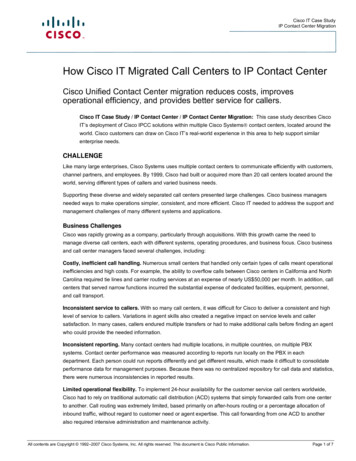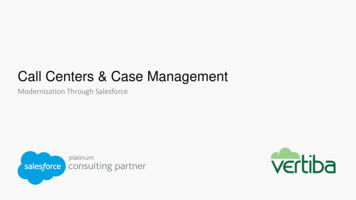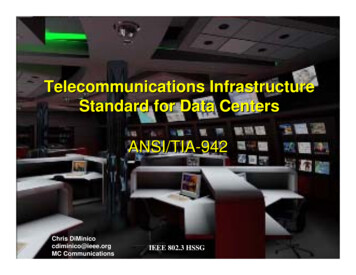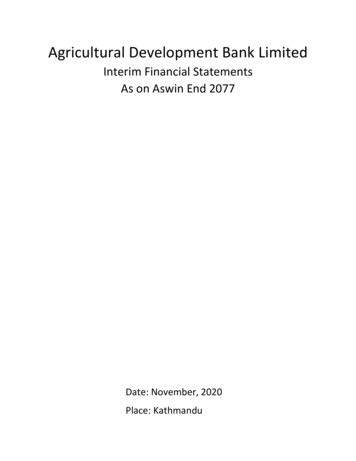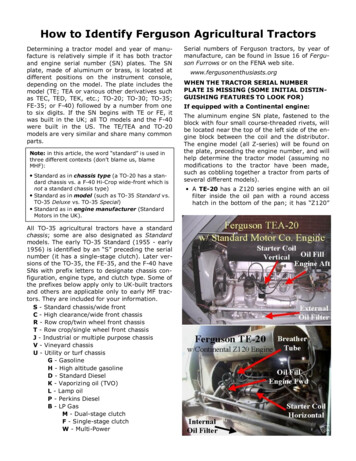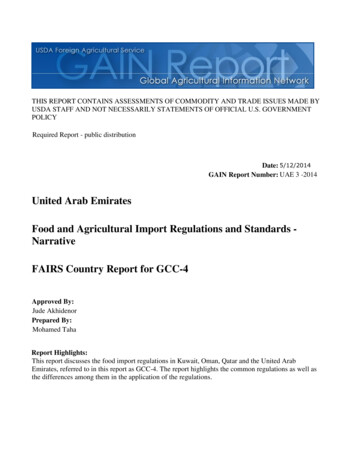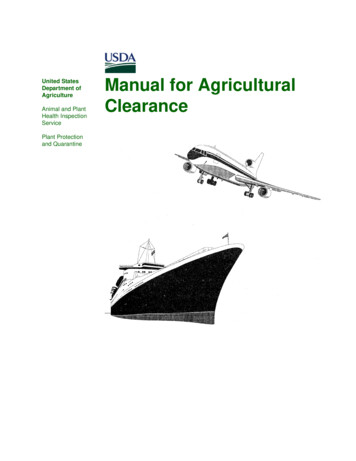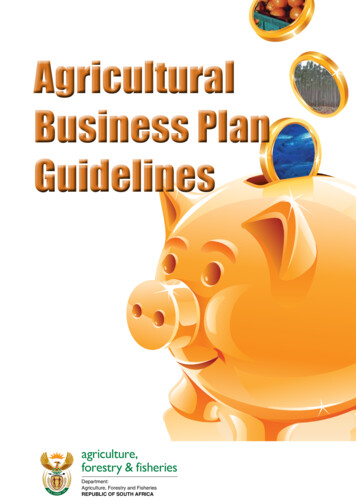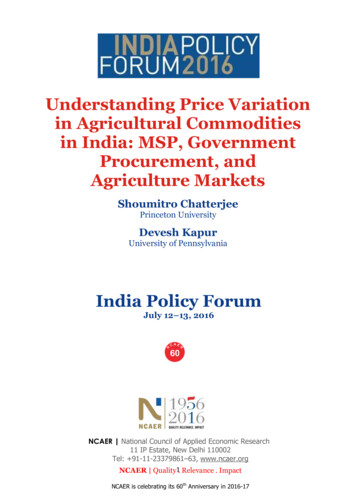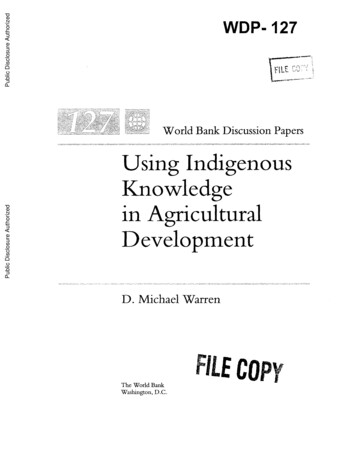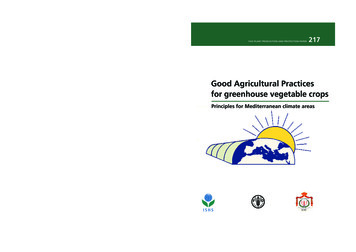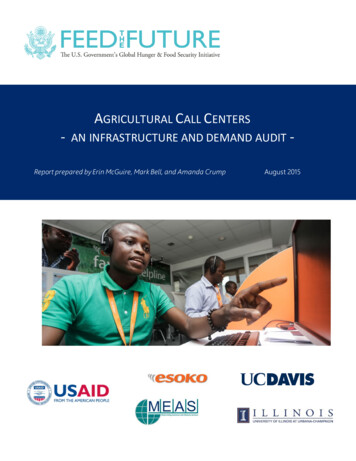
Transcription
-AGRICULTURAL CALL CENTERSAN INFRASTRUCTURE AND DEMAND AUDIT -Report prepared by Erin McGuire, Mark Bell, and Amanda CrumpAugust 2015
Agricultural Call CentersAGRICULTURAL CALL CENTERS:AN INFRASTRUCTURE AND DEMAND AUDITAugust 2015Report prepared byErin McGuire, Mark Bell, Amanda Crump (University of California Davis)
Agricultural Call Centers McGuire, Bell, Crump and MEAS project. This work is licensed under aCreative Commons Attribution 3.0 Unported License.Users are free: To share — to copy, distribute and transmit the work.To remix — to adapt the work.Under the following conditions: Attribution — Users must attribute the work to the authorsbut not in any way that suggests that the authors endorsethe user or the user’s use of the work.Technical editing by Katy Heinz. Production by Katy Heinz.This report was produced as part of the Modernizing Extension and Advisory Services project (MEAS),funded by the United States Agency for International Development (USAID) under the Leader withAssociates Cooperative Agreement No. AID-OAA-L-10-00003.www.meas-extension.orgThe study was made possible by the generous support of the American people through USAID. Thecontents are the responsibility of the author and do not necessarily reflect the views of USAID or theU.S. government.
Agricultural Call CentersTABLE OF CONTENTSAbbreviations. iiiOverview and Recommendations .1ICT and Call Centers in the Agriculture Sector.2User Landscape .3Information Pathways .3Agriculture Information Needs.4Operating Systems and Capacity.5Platforms, Databases, and CRM Software .5Technical Capacity and Costs .5Call Center Operators’ Experience and Languages.7Knowledge Systems and Product Packages.7Knowledge Bank .7Role of Experts and Validation.8Products.9Partnerships. 11Knowledge partnerships. 11Business partnerships . 11Telecommunication partnerships. 11Aid agency linkages. 12Gender Considerations . 12Cost Mitigation. 13Summary . 14References . 15Appendix A. Survey used in data collection in Ghana and Bangladesh. 16Appendix B. Summaries of agriculture categories used in survey . 21Appendix C. Abstract: Best Practices in Technology, Information Systems and Demand-Based Productsfor Agriculture Extension Call Centers . 22Appendix D. Training for Esoko agriculture call center operators and community farmers . 24Appendix E. Field/Workshop Training Report in Tamale . 26Appendix F. Press Release . 28Appendix G. Esoko Callcentre Field Visits with Erin (University of California, Davis Researcher) . 30ii
Agricultural Call CentersABBREVIATIONSAPIApplication Program InterfaceATAAgriculture Transformation AgencyBIIDBangladesh Institute of ICT in DevelopmentCRMCustomer Relationship ManagementGISGeographic Information SystemIVRInteractive Voice RecordingsICTInformation and Communications TechnologiesISDNIntegrated Services Digital NetworkMISMarket Information SystemMNOMobile Network OperatorsNGONon-governmental OrganizationSMSShort Message ServiceSIMSubscriber Identity ModuleUSAIDUnited States Agency for International Developmentiii
Agricultural Call CentersOVERVIEWANDRECOMMENDATIONSIn an environment with ever-decreasing government budgets and limited resources, agricultureextension services have looked toward Information and Communications Technologies (ICT) to helpdisseminate good agricultural information. These mediums include radio, web, film, and among others,mobile phones. Due to high adoption rates, the mobile phone has become a valued means ofcommunication to both extension workers in the field and small-scale agriculture producers. As a result,one of the latest developments in ICT is the agriculture call center – intended to extend resources over alarger number of farmers as well as in some cases, become financially self-sustainable through paymentfor services. Although there are many services that might be attributed to an agriculture call center, forthis paper’s purpose a call center refers to a central location where operators answer questions on thephone from farmers who are usually based in rural areas.The following report is a result of farmer surveys in Ghana and Bangladesh and a six-month audit ofEsoko – a call center based in Ghana – with input from call centers in other parts of Western and EasternAfrica and Asia. Major findings are included below, with subsequent general observations. At the end ofthis report there is a general discussion about financial sustainability within call centers. This evaluationand audit is meant to identify best practices, current challenges, and future opportunities withinagriculture call centers.Much of this study’s information was gleaned from Esoko (as mentioned above). Esoko began asTradeNet in 2005, with the encouragement of the United Nation’s Food and Agriculture Organizationand in partnership with FoodNet in Uganda. TradeNet originally focused on agricultural marketing byproviding the technology and infrastructure to collect and share current market prices online andthrough Short Message Service (SMS) messaging. In 2005, TradeNet signed a three-year agreement withthe United States Aid for International Development’s (USAID) Market Information Systems and Trader’sOrganizations program to adapt the product and make it available to small-scale farmers in over 13countries. In 2009 TradeNet rebranded as Esoko (name derived from the Swahili word “Soko” formarket; the ‘E’ representing electronic), switching to a new platform with a broader set of tools. One oftheir newest services is the agriculture call center, which opened in February of 2013. However, theirexpertise in many information systems has allowed them to quickly become leaders in their field anddevelop the trust and loyalty of many Ghanaian farmers.USAID and the University of California, Davis are very grateful to Esoko and their staff for the manyhours they spent helping researchers understand their systems. If you have further questions aboutEsoko, please contact their Chief Executive Officer, Mark Davies at mark@esoko.com.Six major findings: Most farmers are currently interested in crop management information, such as pest and weedcontrol and fertilization schedules. When offered a variety of potential information services,farmers wanted to know more about weather and market prices. This information suggests thatcall centers should highlight their crop management resources and educate potential clients onthe agriculture call center’s ability to give information on market prices and weather.1
Agricultural Call Centers Building trust with farmer clients is critical. The capacity of the call center operators to speak thelanguages of the different farmer groups, as well as their demonstrated topic expertise werefound to be key in building trust with the farmers.Farmers prefer information sent through voice mechanisms rather than SMS – this preferenceseemed to be due to general literacy issues, plus a lack of basic phone skills.In order to mitigate costs and improve products, partnerships could perhaps be expanded withbusiness entities, research institutions, and telecommunication companies.Women need to be more engaged.Call center financial sustainability is an incredible challenge.ICT AND CALL CENTERSIN THEAGRICULTURE SECTORFor the 70 percent of the world’s population that live in poverty, 48 percent live in rural areas and 39percent are employed in agriculture production (World Bank, 2012). The majority of these farmers aresmallholder farmers that are living off less than US 2 per day (World Bank Statistics, 2011). Investingand increasing income levels of small-scale farmers is essential for poverty reduction in rural areas of thedeveloping world.Studies have shown that the average small-scale farmer suffers from large information gaps in the field.For instance, farmers may not have access to information on how to respond to new pests and diseases(an increasing issue with climate change) or do not know which local market is offering the best price fortheir product (Aker & Mbiti, 2014). Further, they may not have access to an impartial data source, suchas a government extension agent, and must rely on a representative from an input supplier. This limitedaccess to information results in lower production, higher input costs, misuse of dangerous chemicals,and lower profitability (Aker & Mbiti, 2014; Muto & Yamano, 2009).In an environment with ever-decreasing government budgets and limited resources, agricultureextension services have looked toward Information and Communications Technologies (ICT) to helpdisseminate good agricultural information. These mediums include radio, web, film and among others,mobile phones. Due to high adoption rates, the mobile phone has become a valued means ofcommunication to both extension workers in the field and small-scale agriculture producers. As a result,one of the latest developments in ICT is the agriculture call center – intended to extend resources over alarger number of farmers as well as in some cases, become financially self-sustainable through paymentfor its services.Although still a new concept, several call centers or call center-“esque” services have emerged indeveloping economies. Ethiopia’s government partnered with the Agriculture Transformation Agency toopen a call center in June 2014 and just 12 weeks later claimed to have received over 1.5 million callsfrom small-scale producers (Davison, 2014). In India, researchers collaborated with a localnongovernmental organization (NGO) and private enterprise to start Avaaj Otalo, a mobile-phone basedagricultural consulting service. The designers reported a very high rate of enthusiasm for the call center(“unanimous”), and an ongoing study reported that over 50 percent of farmers with access to theservice used the mobile phone hotline within the first seven months, with an average of 7.5 phone calls2
Agricultural Call Centersper farmer (Cole & Fernando, 2012). In Dhaka, the Bangladesh Institute for ICT in Development hascreated e-krishok, a suite of services based around agriculture information being delivered by mobilephone through existing in-field government infrastructure. Further, private entities are diversifyingexisting call centers to include agriculture services. For instance, Miaki in Bangladesh is expanding theirentertainment and health call center to include an agriculture hotline. Miaki is a private entity providingagriculture call lines paid solely by callers, however, overhead costs are mitigated in other ways. Esoko ismanaged through a public-private partnership with social investors and aid contracts
The following report is a result of farmer surveys in Ghana and Bangladeshand a six-month audit of Esoko – a call center based in Ghana – with input from call centers in other parts of Western and Eastern Africa and Asia . Major findings are included below, with subsequent general observations. At the en d of this report there is a general discussion about financial sustainability within .
